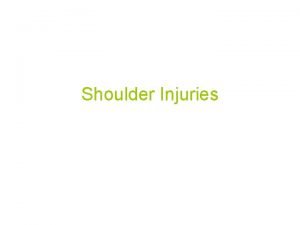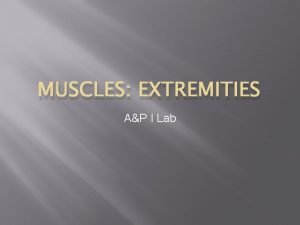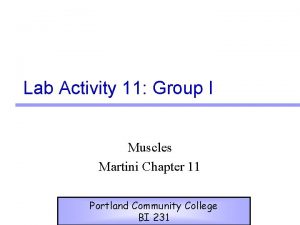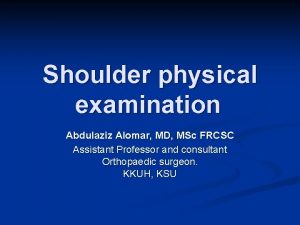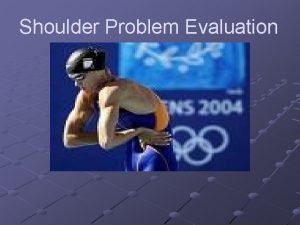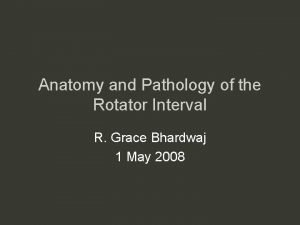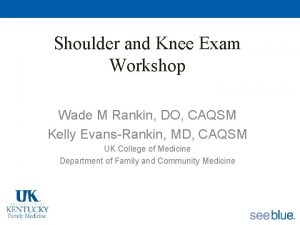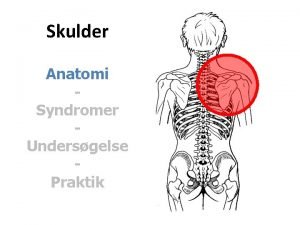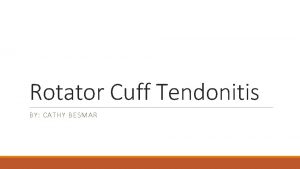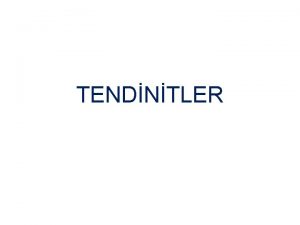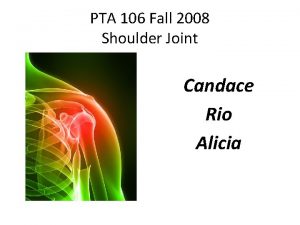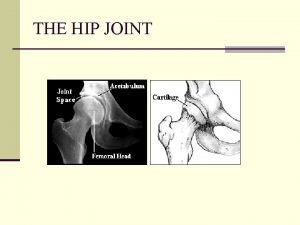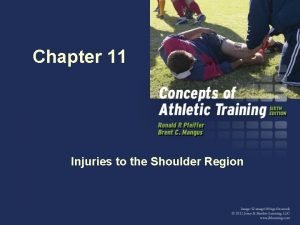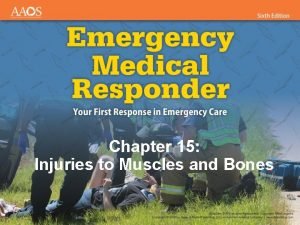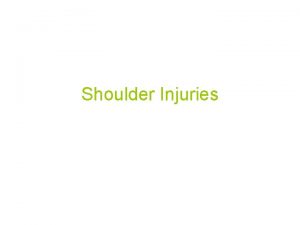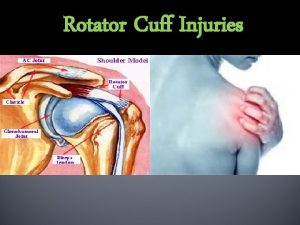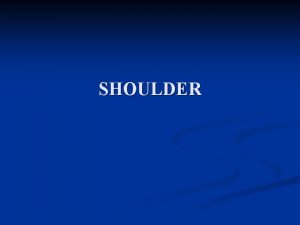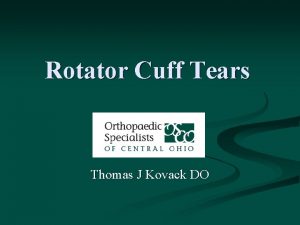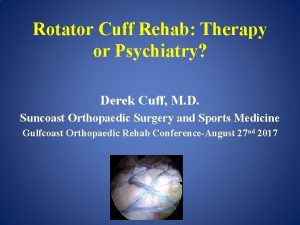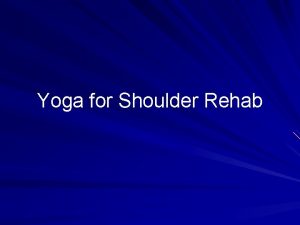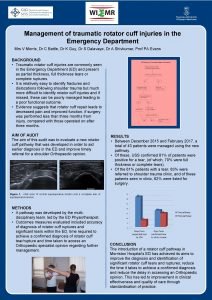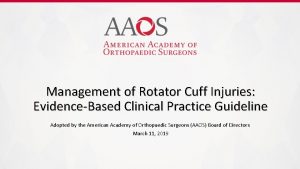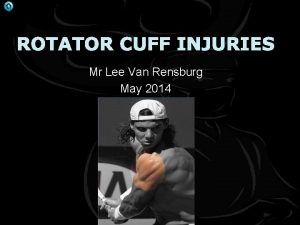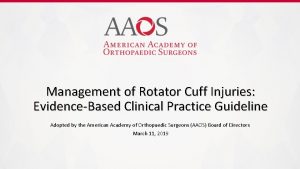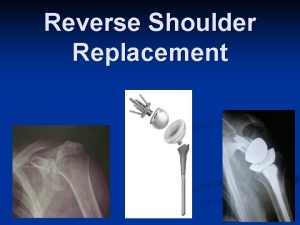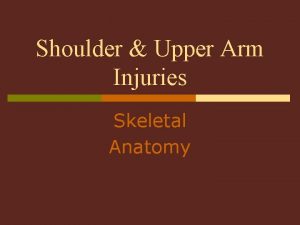Shoulder Injuries Anatomy Anatomy 4 rotator cuff muscles













- Slides: 13

Shoulder Injuries

Anatomy

Anatomy 4 rotator cuff muscles � • • Subscapularis - internal rotator Supraspinatus - abduction Infraspinatus - external rotator Teres minor - external rotator

Recognition and Management of Injuries • Clavicle Fracture Cause: fall on outstretched arm, fall on tip of shoulder, direct impact S&S: supports arm; tilts head toward injured side; clavicle appears a little lower, swelling, point tenderness, mild deformity Care: sling and swath, xray, reduction followed by immobilization 6 -8 wks; sling 3 -4 wks with isometric and mobilization exercises

• Humerus fracture Cause: direct blow, dislocation, impact received by falling on outstretched arm S&S: may be difficult to recognize, pain, inability to move arm, swelling point tenderness Care: splint with sling; prevent shock; referral to physician; 2 -6 months out of competition

• Acromioclavicular (AC) joint sprain (separated shoulder) Cause: fall on outstretched arm, direct impact on shoulder S&S: point tenderness, discomfort, • Grade 1 = no deformity • Grade 2 = definite displacement and prominence of lateral end of clavicle; ROM, • Grade 3 = gross deformity and prominence of distal clavicle; severe pain, loss of movement Care: ice and pressure; immobilization 2 -3 wks; referral ; aggressive rehab-joint mobilization, flexibility and strength exercises

• Glenohumeral dislocations Cause: • Subluxations: – excessive translation of the humeral head without complete separation of the joint surfaces • Anterior glenohumeral dislocation – Forced abduction, external rotation, and extension • Posterior glenohumeral dislocation – Forced abduction and internal rotation of the shoulder or a fall on an extended and internally rotated arm

S&S: flattened deltoid contour; pain; obvious deformity Care: immobilization; reduction; xray; cold packs; muscle reconditioning ASAP; sling for 3 wks; strengthening

• Rotator cuff strains Cause: usually involves supraspinatus muscle; dynamic rotation of the arm at high velocity; long history of shoulder impingement or instability; tears at insertion of humerus S&S: diffuse pain around acromion; overhead activities increase pain; point tenderness; loss of strength due to pain; (+) impingement and empty can Care: RICE; Progressive Resistive Exercise’s; decrease activity

• Shoulder bursitis Cause: trauma or overuse; direct impact S&S: pain with movement; tenderness to palpation in area just under acromion Care: ice; NSAIDs; maintaining full ROM

• Biceps brachii ruptures Cause: performing a powerful concentric or eccentric contraction of the biceps muscle; most commonly occurs near the origin of the muscle S&S: a resounding snap and feels a sudden intense pain; protruding bulge may appear near the middle of the biceps; weakness with elbow flexion and supination of forearm Care: ice, sling; referral to MD; surgery

• Bicipital tenosynovitis Cause: common in overhead activities; repeated stretching of the biceps in highly ballistic activities causing an irritation of the tendon and synovial sheath S&S: tenderness in anterior upper arm; swelling; warmth; crepitus; pain with overhead activities Care: rest for several days; ice; NSAIDs; gradual strengthening and stretching of the biceps muscle; rehab

• Shoulder impingement � Cause: mechanical compression of supraspinatus tendon, the subacromial bursa, and long head of biceps tendon; most common in overhead activities S&S: diffuse pain around the acromion in overhead position; external rotators weaker than internal; tightness in posterior and inferior capsules; Care: restoring normal biomechanics; RICE; strengthening rotator cuff muscles and scapula muscles; modified activity
 Rotator cuff anatomy
Rotator cuff anatomy Adduction of humerus muscles
Adduction of humerus muscles Posterior belly of digastric insertion
Posterior belly of digastric insertion Rotator cuff examination
Rotator cuff examination Teres minor test
Teres minor test Coracohumeral
Coracohumeral Reverse lachman's test
Reverse lachman's test Skulder anatomi muskler
Skulder anatomi muskler Rotator cuff tendinitis
Rotator cuff tendinitis Kalsifik tendinit
Kalsifik tendinit Rotator cuff innervation
Rotator cuff innervation Gluteus maximus adduction
Gluteus maximus adduction Chapter 11 injuries to the shoulder region
Chapter 11 injuries to the shoulder region Emr chapter 15 injuries to muscles and bones
Emr chapter 15 injuries to muscles and bones
